Introduction
Curious about the buzz around the Japanese Mounjaro drink? This article dives into what makes this detox beverage unique, how it supports wellness, and how you can easily prepare it at home. We’ll walk through its origins, the story behind its rise, and practical ways to include it in your healthy routine. Whether you want a morning boost, a gentle cleanse, or a new go-to homemade drink, you’ll find everything you need to get started—no complicated ingredients, no fads, just fresh, simple goodness.
Table Of Content
Table of Contents
The Story of Japanese Mounjaro
From Tokyo Teahouse to Your Kitchen
It all started during a rainy spring afternoon in Tokyo, wandering the narrow lanes behind a small tea house. I remember the aroma that pulled me in—a blend of green tea, ginger, and something tangy that made the whole place feel warm and alive. I sat by the window, listening to soft chatter and watching steam rise from my cup. That was the first time I tasted what’s now known as the Japanese Mounjaro drink. The first sip brought an immediate sense of clarity and comfort, unlike any detox or wellness drink I’d tried before.
For years, I searched for ways to recreate that feeling at home—something soothing, packed with nutrients, and easy enough to make even on the busiest days. Japanese Mounjaro quickly became my favorite ritual, whether I needed to settle my stomach, refresh my senses, or simply unwind after a long day. It’s more than a trendy beverage—it’s a tradition that connects comfort, culture, and well-being in every cup.
What is japanese mounjaro
There’s a lot of confusion about the term “Japanese Mounjaro.” You might have seen it trending as a weight-loss miracle or a viral health hack, but its roots are much deeper. The authentic Japanese Mounjaro drink blends matcha green tea, umeboshi (pickled plum), kombu (seaweed), and fresh ginger. Each ingredient carries centuries of tradition and wellness wisdom from Japanese culture.
Unlike the popular prescription medication with a similar name, this Japanese Mounjaro is a food-based, caffeine-boosted drink meant to support digestion and metabolism naturally. No artificial stimulants, no shortcuts—just time-honored flavors working together to help you feel your best. People have embraced this drink for its comforting warmth, gentle detox effects, and the sense of calm it brings, especially during busy or stressful times. The experience is not just about taste but about making time for yourself and honoring your health with every cup.

Japanese Mounjaro Recipe
Ingredients
Method
- Place the kombu in a cup and pour in the hot water. Let it steep for five minutes.

- Remove the kombu and add the matcha powder. Whisk until smooth and frothy.

- Add the umeboshi, mashing it gently into the drink.

- Stir in the freshly grated ginger.

- Let the mixture sit for one minute, then strain or enjoy as is.
Notes
Ingredients & Health Benefits Of Japanese Mounjaro
The Key Ingredients Behind Japanese Mounjaro
The Japanese Mounjaro drink stands out thanks to its fresh, powerful ingredients, each chosen for a specific reason. At the heart of the recipe is matcha, a finely ground green tea powder that’s been a staple in Japanese culture for centuries. Matcha brings a vibrant green color, a clean taste, and a gentle caffeine lift that helps you stay alert without the crash.
Another key ingredient is umeboshi, the pickled Japanese plum. It’s salty, tangy, and brings a unique depth to the drink. Umeboshi is famous in Japan for supporting digestion, especially after rich or heavy meals. Kombu, a mineral-rich seaweed, adds umami and natural electrolytes, while fresh ginger ties everything together with a subtle heat that’s both soothing and invigorating.
Many people choose Japanese Mounjaro for its reputation as a natural “reset” button. The ingredients aren’t just trendy—they’re time-tested wellness tools. Matcha offers antioxidants, umeboshi helps balance gut health, kombu boosts mineral intake, and ginger eases digestion. This combination makes Japanese Mounjaro much more than just a comforting beverage; it’s a smart addition to any daily routine.
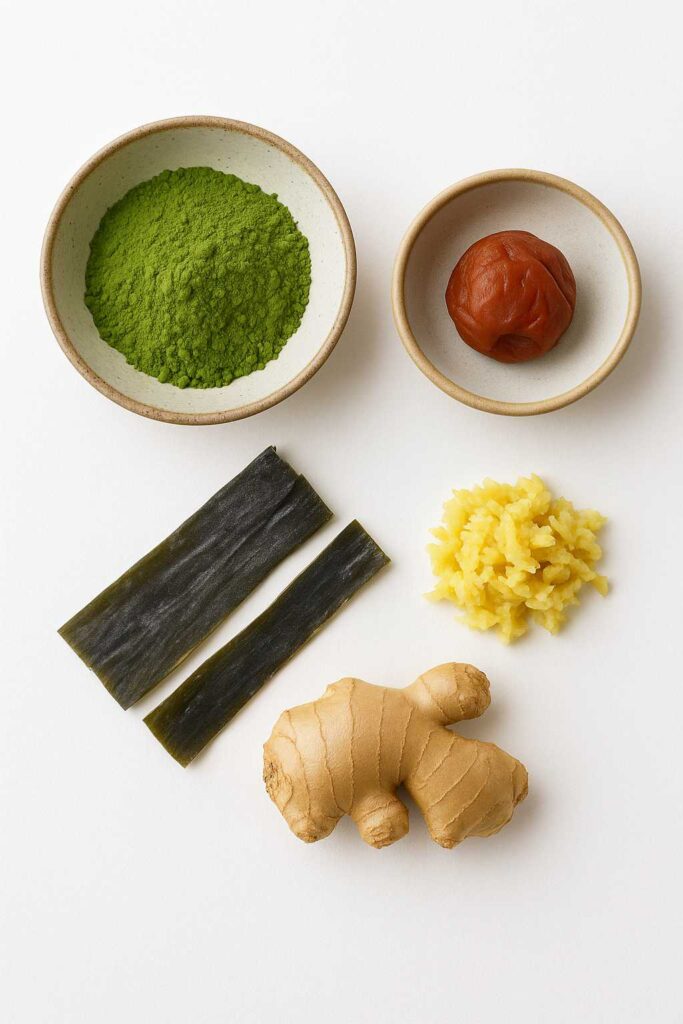
Nutrition Snapshot: Why Japanese Mounjaro Supports Wellness
Japanese Mounjaro earns its place as a favorite wellness drink by packing a lot of nutrition into one simple cup. To give you a clearer picture, here’s a nutrition snapshot based on the classic recipe:
Most of the calories come from the small amount of carbohydrates in the plum and the matcha. Antioxidants come from the green tea, supporting cell health and natural energy. Kombu and umeboshi provide sodium and essential minerals, which can help replenish electrolytes if you’re feeling run down. Ginger adds its signature zing, plus anti-inflammatory benefits.
The real magic is in how these ingredients work together. Japanese Mounjaro supports healthy digestion, provides a gentle energy boost, and offers antioxidant protection, all while being light and easy to enjoy every day. For many, it’s also become a go-to option for those seeking Japanese Mounjaro weight loss benefits, thanks to its natural ingredients and low-calorie profile.
How to Make Japanese Mounjaro at Home
Step-by-Step Japanese Mounjaro Recipe
Preparing Japanese Mounjaro at home is simple and satisfying. You don’t need special equipment, and the ingredients are simple to find if you have access to a good Asian grocery or online store. Here’s a straightforward recipe that anyone can follow:
Ingredients:
- Matcha green tea powder
- Umeboshi (Japanese pickled plum), pitted
- Kombu
- Freshly grated ginger
- Water
Instructions:
- Place the kombu in a cup or heatproof jar and pour in the hot water. Let it steep for five minutes, allowing minerals to infuse into the water.
- Remove the kombu and add the matcha powder to the cup. Use a small whisk or spoon to blend until smooth and frothy.
- Add the umeboshi, mashing it gently into the liquid so its salty, tangy flavor mixes throughout.
- Stir in the freshly grated ginger, giving the drink its gentle heat and digestive support.
- Let the mixture sit for one more minute to marry the flavors. Strain if you want a smooth finish, or sip as is for extra nutrition.

That’s it—the authentic Japanese Mounjaro is ready. It comes together in less than ten minutes and requires only a handful of ingredients. The flavor is both earthy and bright, with a depth that comes from the careful balance of salty, sweet, sour, and a hint of spice.
Tips for Getting the Most from Your Homemade Drink
For the best Japanese Mounjaro experience, use the freshest ingredients you can find. Real matcha makes a difference, providing a clean flavor and the most antioxidants. Umeboshi can be found at specialty Asian markets or online, and even one plum goes a long way for taste and gut health.
If you haven’t used kombu before, start by slicing it into smaller sections so you can control how much mineral flavor you get. Letting it steep longer will give the drink a more noticeable sea taste. You can also adjust the ginger to suit your preference—add more for a spicier drink or just a touch for a softer, balanced note.
You can enjoy Japanese Mounjaro hot or at room temperature, but avoid boiling water, which can make the matcha bitter. If you want a cold version, prepare it as above and pour over ice, or chill before serving.
Don’t be afraid to personalize your recipe. Some add a squeeze of lemon or a few mint leaves for extra brightness. Others skip the straining step for more fiber. No matter how you prepare it, Japanese Mounjaro is designed to suit your preferences and lifestyle.Try sipping it first thing in the morning, after a big meal, or as an afternoon pick-me-up.
Enjoying Japanese Mounjaro in Your Daily Routine
When and How to Drink Japanese Mounjaro
Japanese Mounjaro fits easily into any healthy lifestyle. Some people enjoy it as a morning ritual, replacing coffee or black tea with this lighter, nutrient-rich drink. Its gentle caffeine from matcha provides just enough lift without feeling jittery. Others like to sip Japanese Mounjaro after meals, letting the umeboshi and ginger soothe digestion and the kombu replenish minerals. For those interested in Japanese Mounjaro weight loss support, making this drink a daily habit is a simple way to add natural, low-calorie wellness to your routine.
If you’re curious about other simple wellness drinks, you might also enjoy Brazilian Mounjaro, which features green tea, ginger, and lemon for a different but equally refreshing ritual.
If you’re curious about other simple wellness drinks, you might also enjoy Brazilian Mounjaro, which features green tea, ginger, and lemon for a different but equally refreshing ritual. For even more healthy inspiration, check out the Natural Zepbound Recipe for a metabolism-friendly daily drink or the Ozempic Detox Juice for a nutrient-packed, energizing option.
For busy days, Japanese Mounjaro works well as a calming break. You can prepare a cup in advance, pour it into a thermos, and take it with you to work or while running errands. Because the recipe is so simple, it’s easy to make a fresh cup whenever you need a little reset. The combination of warming ginger, tangy plum, and earthy matcha turns even a short pause into a moment of self-care.
Japanese Mounjaro can also be a comforting drink in the evening, especially if you crave something nourishing but light before bed. Since the caffeine content is lower than in coffee, most people find it gentle enough not to disturb sleep, particularly if you use less matcha in your evening version.
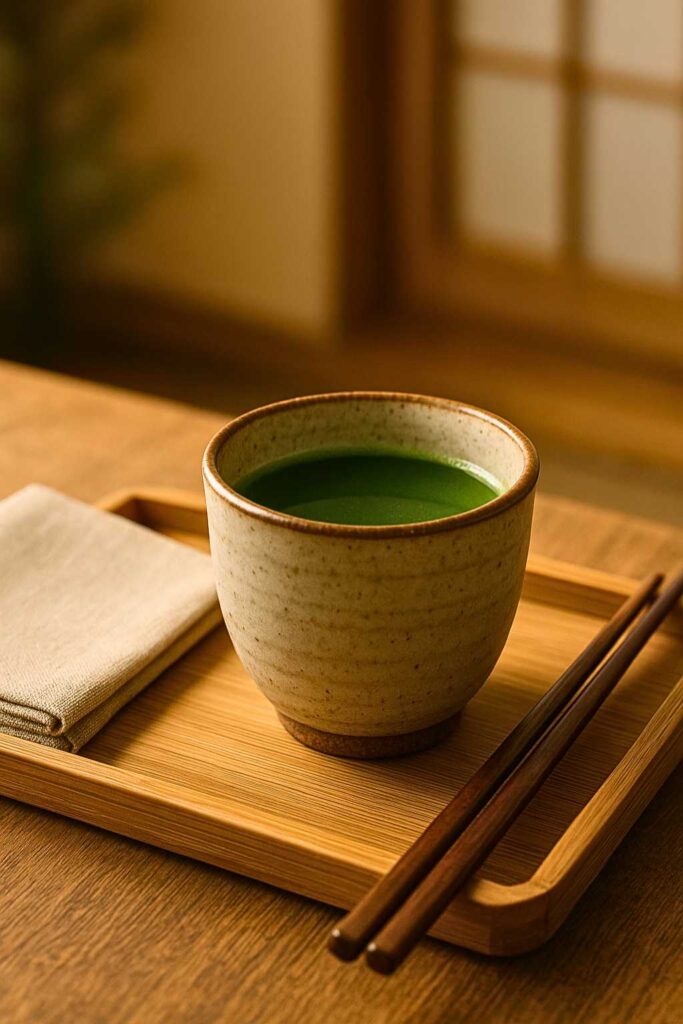
Simple Variations for Every Taste
One of the best things about Japanese Mounjaro is its flexibility. You can start with the basic recipe and tailor it to match your personal taste or health goals. Prefer something sweeter? Add a few drops of monk fruit or stevia to keep the drink sugar-free. Like more citrus? A squeeze of lemon or yuzu juice brightens the flavors and adds vitamin C.
If you want a vegan or gluten-free version, all the core ingredients already fit those diets—no changes needed. Some people enjoy adding a splash of coconut water for extra hydration, or a pinch of chili flakes for a subtle kick. If umeboshi is too strong, try using half a plum or swapping in a bit of apple cider vinegar for a milder tang.
You can also experiment with the method. For a cold version, prepare the drink as usual and let it chill in the fridge, or shake it with ice for a refreshing summer beverage. Add a few mint leaves or a piece of cucumber for a new twist. Japanese Mounjaro is designed to be as versatile as your lifestyle, giving you plenty of ways to enjoy it every day, whether you’re at home or on the go.
Conclusion
Japanese Mounjaro isn’t just another health trend—it’s a meaningful ritual rooted in Japanese tradition, crafted from a handful of powerful ingredients. This drink blends the antioxidant strength of matcha, the tangy depth of umeboshi, the mineral boost of kombu, and the soothing warmth of ginger into a single cup that supports wellness and daily balance. Simple to prepare, endlessly adaptable, and truly satisfying, Japanese Mounjaro can fit into any healthy lifestyle.
Start your day with a gentle lift, refresh after a meal, or wind down in the evening with this nutrient-rich drink. As you experiment with flavors and make Japanese Mounjaro your own, you’ll discover new ways to nurture both body and spirit, one cup at a time.
For even more creative and healthy drink ideas, visit my Pinterest board on healthy drinks and explore new recipes to inspire your wellness journey.
Frequently Asked Questions
What is Japanese Mounjaro drink?
Japanese Mounjaro is a traditional wellness beverage made from matcha green tea, umeboshi (pickled plum), kombu seaweed, and fresh ginger. Unlike the prescription medicine with a similar name, this drink is all about natural ingredients and centuries-old Japanese health traditions. It supports digestion, provides gentle energy, and helps replenish minerals—making it a favorite for anyone seeking a natural, daily wellness ritual.
Does the Mounjaro drink really work?
Many people who try natural Mounjaro drink find it soothing and supportive, especially for digestion and energy. The drink’s ingredients—matcha for antioxidants and mild caffeine, umeboshi for gut health, kombu for minerals, and ginger for digestive ease—work together to help you feel refreshed. While everyone’s body is different, those who include Japanese Mounjaro in their daily routine often report feeling more balanced and comfortable, especially after meals.
How to make Japanese homemade Mounjaro?
It’s easy to make japanese mounjaro recipe at home. Combine 1 teaspoon matcha powder, 1 small umeboshi, a piece of kombu (about 2 inches), and 1/2 teaspoon freshly grated ginger with 1 cup of hot, filtered water. Start by steeping the kombu, then mix in the remaining ingredients, whisk, and serve. Feel free to modify the flavors to your liking or try chilled versions when it’s warm outside.
What is the Japanese trick for weight loss?
The Japanese approach to weight loss usually means eating mindfully and choosing wholesome, uncomplicated foods such as Japanese Mounjaro tea. This approach emphasizes fresh, whole ingredients, portion control, and taking time to enjoy each meal. Drinks like Japanese Mounjaro tea, made with matcha, umeboshi, kombu, and ginger, fit right into this tradition. They are low in calories, naturally support digestion, and help create healthy eating habits that can make a big difference over time.
What are the 3 ingredients in brazilian mounjaro?
The Brazilian Mounjaro drink, which you might find online, is different from the Japanese variety. Typically, it uses just three ingredients: green tea, lemon juice, and ginger. While it shares some similarities—like the use of green tea and ginger—it lacks the unique flavor and wellness properties of umeboshi and kombu. If you want the traditional Japanese Mounjaro experience, stick to the classic recipe outlined in this article.
What Japanese herb is used for weight loss?
One well-known Japanese herb used for weight loss is matcha, a powdered green tea leaf. Matcha is rich in antioxidants and provides a gentle energy boost, which can support metabolism and help people maintain healthy habits. Umeboshi, a type of pickled plum, is also valued in Japanese culture for its digestive benefits and role in healthy eating routines.
Does the Japanese Mounjaro drink work?
The so-called “Japanese Mounjaro drink” may aid weight loss when paired with a healthy diet and routine, but it’s not a magic fix—consistency is key.
What is the Japanese secret to losing belly fat?
The secret lies in simple habits: warm detox teas, fiber-rich foods, small portions, walking daily, and mindful breathing like the “Japanese long-breath” technique.
What is the Japanese 4 ingredient drink to lose weight?
A popular version combines warm water, lemon juice, matcha green tea, and apple cider vinegar—known for boosting metabolism and aiding digestion naturally.

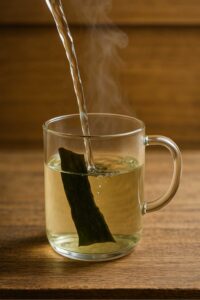

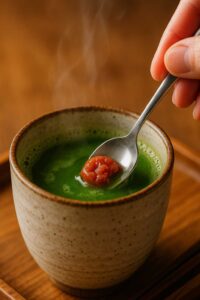
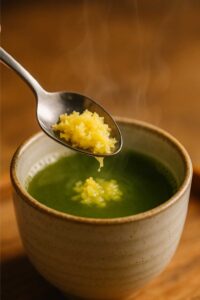
3 thoughts on “Japanese Mounjaro: The Authentic Wellness Drink That’s Changing Healthy Routines”